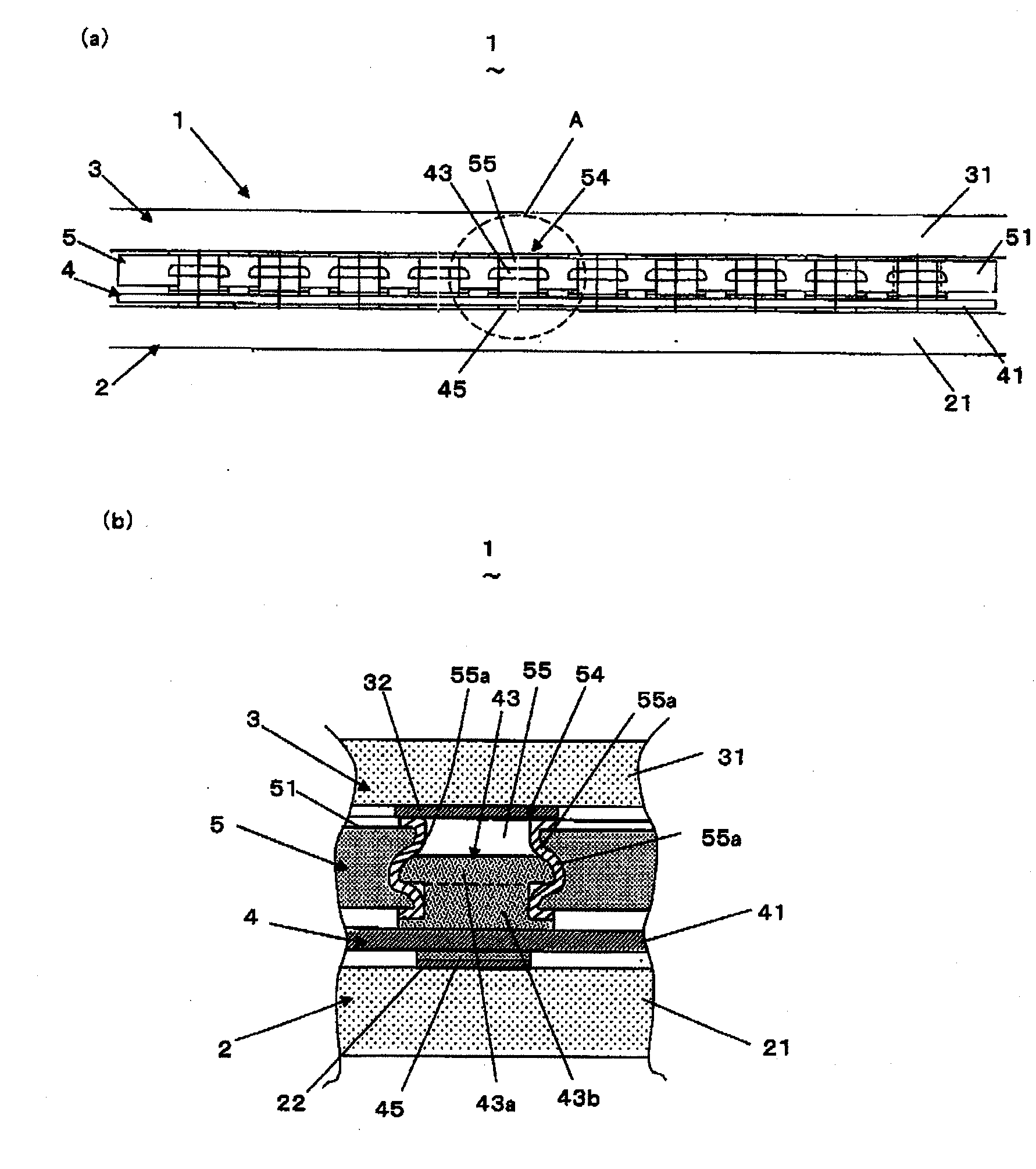Board-to-board connector
a technology of connectors and boards, applied in the direction of dielectric characteristics, coupling device connections, printed element electric connection formation, etc., can solve the problems of reduced binding strength between the contact and the post due to engagement, difficult bending of the contact, and difficulty in ensuring sufficient contact area, etc., to achieve the effect of convenient processing
- Summary
- Abstract
- Description
- Claims
- Application Information
AI Technical Summary
Benefits of technology
Problems solved by technology
Method used
Image
Examples
first embodiment
[0057]Hereinafter, a board-to-board connector in accordance with First embodiment of the present invention will be described with reference to FIG. 1 to FIG. 5. The board-to-board connector 1 in this embodiment has a first connector 4 and a second connector 5 for board-to-board connection, which are connected to circuit boards 2 and 3, respectively. The first connector 4 and the second connector 5 are electrically connected to a circuit pattern 22 formed on an insulative substrate 21 of the circuit board 2 and a circuit pattern 32 formed on an insulative substrate 31 of the circuit board 3, respectively. The board-to-board connector 1 connects the circuit boards 2, 3 by connecting the first connector 4 to the second connector 5.
[0058]As shown in FIG. 1, the first connector 4 has a substrate 41 made of an insulative member and a conductive pattern 42 provided on the surface of the substrate 41 (the upper surface in FIG. 1). On the conductive pattern 42 are provided a conductive bump ...
second embodiment
[0080]The connector 4 is connected to the connector 5 by inserting the bump 43 into the elastic conductive section 62 of the connector 5. This connection is the same as the connection in Second embodiment except that the elastic conductive section 62 protrudes from the surface of the substrate 51a on the connection plane of the connector 5 by the height d2 of the gate 64, detailed description thereof is omitted.
[0081]As described above, according to this embodiment, since the conductive pattern is integrally formed on the substrate 51 and in the through hole 55 without forming a groove on the circuit board, manufacturing processes become simple, leading to reduction in manufacturing costs. Further, groove processing of further decreasing the intensity of the thin substrate having low intensity is not carried out, the intensity of the connector can be prevented from lowering. Furthermore, since the conductive rubber 6 protrudes from the surface of the substrate 51 by the height of th...
third embodiment
[0083]In the second connector 5, the elastic substrate 51, as shown in FIG. 16, FIG. 17, comprises the insulative substrate 51a having a circuit pattern (conductive pattern) connected to each surface thereof through the through hole 55 and the conductive rubber sheet 6a obtained by making the conductive rubber 6 in the shape of a sheet. A copper foil 7 is stuck on the surface of the conductive rubber sheet 6a and a copper foil pattern 71 of the copper foil 7 is integrated with the conductive pattern 61 of the conductive rubber sheet 6a. The elastic conductive section 62 having the through hole 63 into which the bump 43 of the first connector 4 is inserted is formed on the conductive rubber sheet 6a. The through hole 73 corresponding to the through hole 63 of the conductive pattern 61 is provided on the copper foil pattern 71. A land pattern 72 joined to the circuit conductive pattern 53 of the substrate 51a is provided on the copper foil pattern 71 surrounding the through hole 73. T...
PUM
 Login to View More
Login to View More Abstract
Description
Claims
Application Information
 Login to View More
Login to View More - R&D
- Intellectual Property
- Life Sciences
- Materials
- Tech Scout
- Unparalleled Data Quality
- Higher Quality Content
- 60% Fewer Hallucinations
Browse by: Latest US Patents, China's latest patents, Technical Efficacy Thesaurus, Application Domain, Technology Topic, Popular Technical Reports.
© 2025 PatSnap. All rights reserved.Legal|Privacy policy|Modern Slavery Act Transparency Statement|Sitemap|About US| Contact US: help@patsnap.com



